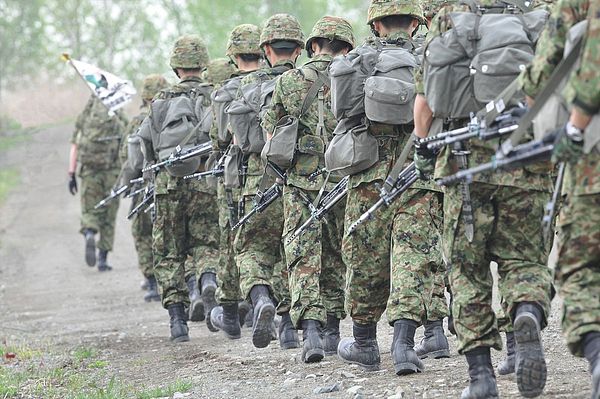Japan’s Defense Ministry has decided to establish a Permanent Joint Headquarters in March 2025 that will centrally oversee the nation’s Ground, Maritime and Air Self-Defense Forces to prepare for any possible emergencies – especially with a Taiwan contingency in mind.
On August 31, the Defense Ministry requested 10.5 billion yen ($71.2 million) for fiscal year 2024 to fund initial costs for setting up the permanent joint operational headquarters at the ministry’s headquarters in Ichigaya, in central Tokyo.
The Defense Ministry explained at its press briefing on the budget request for the next fiscal year that the new permanent joint command will start with about 240 members initially, and that it will be established at the end of fiscal year 2024, which is March 2025 in Japan.
The announcement came after the National Defense Strategy and the Defense Buildup Program, both approved by the National Security Council and the Cabinet in December 2022, called for reinforcing effectiveness of the joint operational posture of Japan’s three Self-Defense Force (SDF) services.
Diplomat Brief
Weekly Newsletter
Get briefed on the story of the week, and developing stories to watch across the Asia-Pacific.
Get the Newsletter
“A Permanent Joint Headquarters will be established in order to build a system capable of seamlessly conducting cross-domain operations at all stages from peacetime to contingency, with the aim of strengthening the effectiveness of joint operations among each SDF services,” the Defense Buildup Program states.
“In this regard, in light of the rapidly increasing severity of the security environment surrounding Japan, MOD/SDF will make every effort to pursue the establishment of a Permanent Joint Headquarters as soon as possible,” it added.
Expanding on the reason for establishing this new joint headquarters, a defense official said at the press briefing in August, “We recognize that it is essential to organically integrate the domains of space, cyber, and electromagnetic waves with the domains of land, sea, and air, and to conduct flexible and sustainable activities through integrated operations.”
This statement clearly highlights the growing importance of hybrid warfare for the SDFs, with an eye on China’s multi-domain Taiwan strategy.
Advertisement
Per the Defense Ministry, currently, the chief of the SDF’s Joint Staff is not a commander, but an aide who assists the defense minister in decision-making regarding the operation of the SDFs.
The role of the new permanent joint commander will be to centrally command the units in both peacetime and emergencies regarding the operation of the SDFs. The commander will develop joint operational plans and carry out those operations by assigning necessary duties to lower commanding officers.
The permanent joint commander will be an officer with the same rank as the three chiefs of staff of the land, sea, and air forces, according to the ministry.
There is a bitter lesson behind this reorganization of the command structures of the JSDFs. In the aftermath of the March 11, 2011 Great East Japan triple disaster (earthquake, tsunami and nuclear accident), it became evident that General Oriki Ryoichi, then the JSDF Chief of Staff of the Joint Staff, was overloaded with an enormous amount of work. He was forced to command the entire SDFs in the disaster relief mission, in addition to being responsible for providing explanations to the prime minister and the defense minister, and to coordinating with the U.S. military.
Since then, there have been widespread and strong opinions among defense experts that the head of the Joint Staff should distribute some of those roles to others.
Additionally, the existing system has lacked the ability to coordinate with the United States’ Indo-Pacific Command. This is because the counterpart of Japan’s chief of the Joint Staff is the chairman of the Joint Chiefs of Staff in the U.S. military, meaning Japan lacks a natural point person for engaging with INDOPACOM. The new permanent joint commander will be the counterpart of the commander of the U.S. Indo-Pacific Command, solving that issue.
Looking back, a bipartisan study group at the Washington-based Center for Strategic and International Studies think tank called for creating a Japanese Joint Operations Command in a report published in October 2018.
“Just as the United States needs to update its command and control arrangements, so too does Japan,” pointed out the fourth version of the so-called Armitage-Nye report, led by former Deputy Secretary of State Richard Armitage and Joseph Nye, former dean of Harvard University’s John F. Kennedy School of Government.
The report continued:
Japan’s existing command structures place too great a burden on the chief of staff of the Japan Self-Defense Forces. At present, the chief of staff effectively serves as both a combatant commander and chief of defense. Disaggregating these duties would increase the operational effectiveness of Japanese forces, particularly during a major contingency. Therefore, Japan should devolve some of the chief of staff’s responsibilities to a subordinate commander.
Advertisement
As tensions between China and Taiwan have risen in recent years, so calls have grown in Tokyo and Washington for closer coordination between the JSDF and the U.S. military as well.
In a panel discussion at a CSIS/Nikkei Symposium in Tokyo on October 2022, Gary Roughead, the former U.S. chief of naval operations, said a combined Japan-U.S. military headquarters could function as a “standalone” entity in guiding operations in the Indo-Pacific.
But Prime Minister Kishida Fumio has played down the prospects of Japan and the United States establishing joint command-and-control operations in a possible Taiwan emergency.
Citing Kishida, the prime minister’s press office told Janes Defence Weekly in November 2022 that the JSDF and the U.S. military operate under “independent command systems” in line with Japanese government regulations and the country’ constitution.

